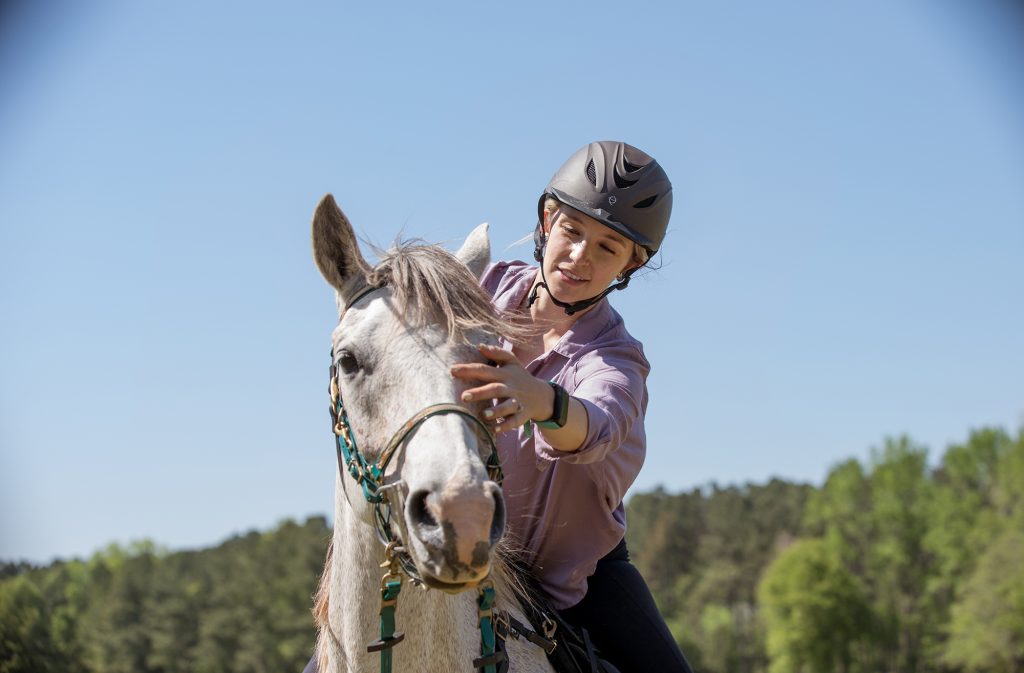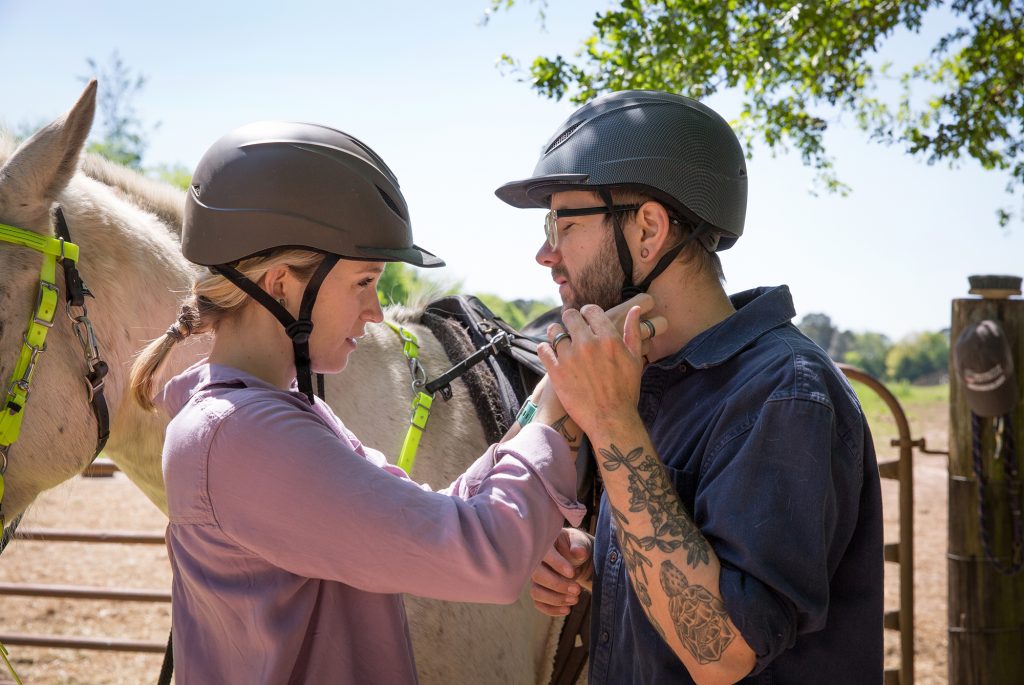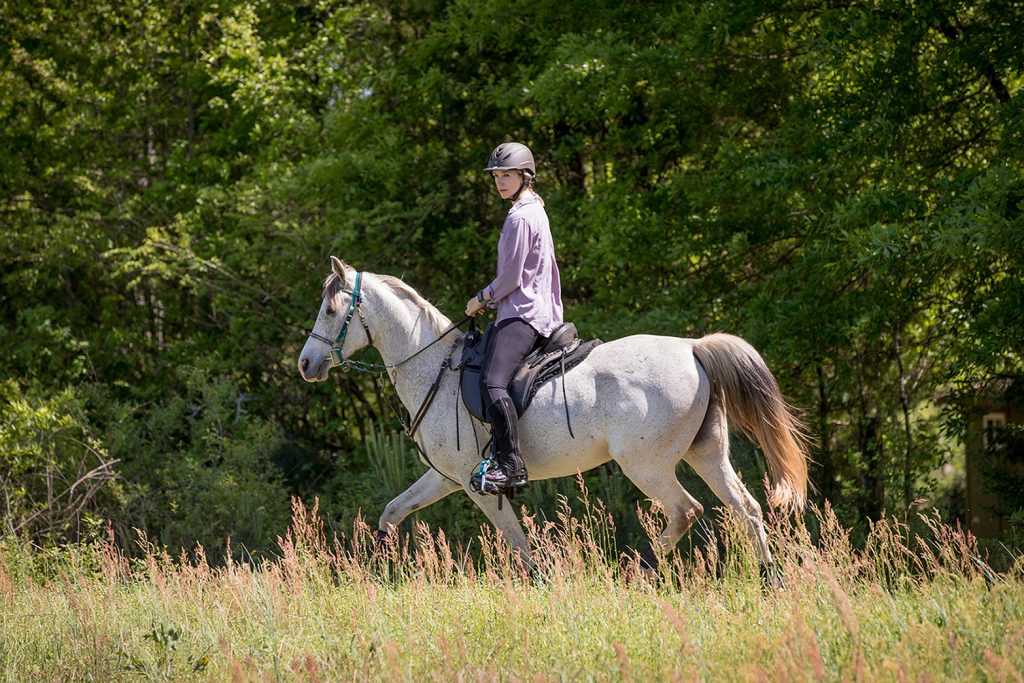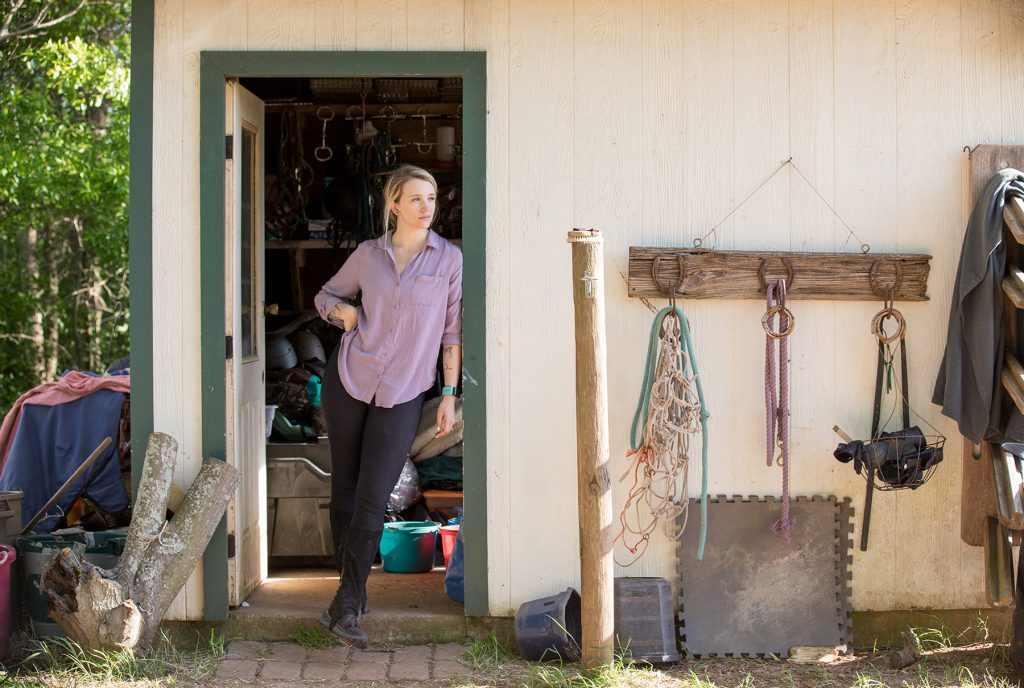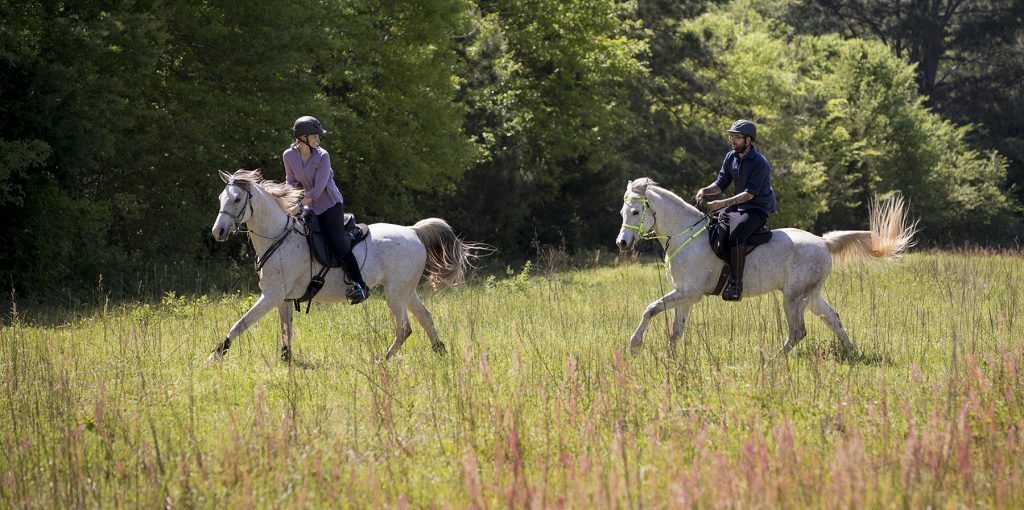Isabelle Holland Lulewicz: In for the Long Haul, this Doctoral Student Endures and Strengthens
By Cynthia Adams | Photos by Nancy Evelyn
You may know about horsemanship and riding. You may even have watched equestrian sports like dressage and steeplechase.
But have you heard of endurance riding?
The sport reaches back to the 1860s and derives from the briefly lived Pony Express, according to the International Federation of Equestrian Sports, or FEI. (See https://www.youtube.com/watch?v=hDoPQ4jJ5jM.) The Pony Express once ferried mail from Missouri to California within 10 days. The costs of the service were extremely high in relative terms and the terms under which the express existed were stringent. The riders could not exceed 125 lbs. in weight, as their horses carried an additional 40 lbs. of mail and other material to total 165 lbs. in full. It was strenuous, hazardous, and more than one rider lost their life under attack or other hazards.
One of the remnants of its history is the sport called endurance riding. Endurance riding involves riding long distances, and participants in events must adhere to strict guidelines concerning the horses and their well-being. Events in the sport of endurance riding involve trails or cross-country rides over a single day or multiple days. Distances undertaken can involve as few as 25 miles or as many as 100.
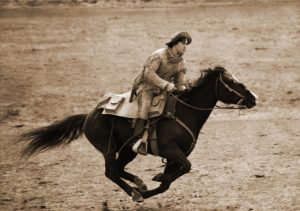
The Pony Express. The pay was good. Yet the posted job requirements for Pony Express riders summed up the obvious dangers: Wanted: Young, skinny, wiry fellows not over eighteen. Must be expert riders, willing to risk death daily. Orphans preferred. HTTPS://STJOMO.COM/THE-PONY-EXPRESS/
Doctoral student Isabelle Holland Lulewicz is an avid horsewoman who enjoys the sport of endurance riding. She is also a scientist and anthropologist keeping to a much longer course: to earn her third UGA degree in the fall of 2019. She completed undergraduate degrees in anthropology and geology in 2015 and entered graduate studies.
Lulewicz draws parallels between endurance riding and academia. “Like my dissertation, to finish is to win!” she declares during spring break when she can find what has become a constant place of solace—taking a long, relaxing ride.
When she jokes that riding is a magnificent obsession, Lulewicz is more than half-serious. “I have hay in my boots right now.” She smiles broadly.
“I started riding in the womb.”
By the age of eight, she was riding competitively, which included jumping, following her horsewoman mom’s lead into equestrian sports.
Lulewicz’s most recent long ride was in Dawsonville, Ga., where she sometimes takes her Arabian, Natasha for long training rides. Natasha stands at 60.1”, or 15.1 hands, the measurement for a horse’s height.
Many would be intimidated, but not this rider, whose family are intensely invested in equestrian life.
She was initially pulled into the sport by her Mom, who is both a lifelong rider and trainer. She attributes the majority of her successes to the immeasurable support and guidance she has provided.
“I rode from ages 8-14, then I started in a different sport, called mounted games, which are relay races on horseback. I did this in events up and down the East coast.”
Lulewicz rode in the United States Pony Club throughout her youth until age 18. The organization was founded in the mid-1950s and has over 10,000 members nationwide. The “pony” in the name refers more to the youth of its members rather than the size of their horses—members must be younger than 21. She competed heavily in this sport until her horse died en route to an event. Devastated by the loss, she left mounted games behind.
She solely took up dressage, which has always made a huge imprint upon Lulewicz and how she approaches her relationship with horses, finding it foundational to all riding.
Dressage is an intricate style of horse training, often described as an artform. During competitive events, the International Equestrian Federation reports “horse and rider are expected to perform from memory a series of predetermined movements.” Dressage is so demanding an activity that it has become a recognized Olympic sport.
Lulewicz formerly worked with an Olympic dressage rider, who wound up giving her his horse. Today, the formerly stressed out horse is no longer pressured to perform. Instead, the contented horse “eats apple pie from McDonalds and lives the life.” She laughs, chortling that “he’s the biggest pocket pony ever at 1,600 lbs.”
Now Lulewicz practices what she calls “balanced riding” as the culmination of her training. “I did eventing when in the US Pony Club,” she says, “but it took me a long time to get where I am today. I’ve worked cows, I’ve done reining. When you have that dressage and balanced riding background, you should have the ability to do well in any sport.”
As she explains, balanced riding is a component of every equestrian sport. “If you’re not doing something right, they (the horse) knows it.”
Lulewicz is a hardy horsewoman and claims that “dirt and horse sweat were the basis of my diet until I went to college and had to go live in a dorm.” Dorm life required a different sort of sacrifice of the outdoorswoman; it was no accident she chose disciplines that involved long hours working outdoors.
Lulewicz descends from a long line of equestriennes and horse lovers. She has always lived on a farm and been around horses, and the life she enjoyed was rugged and demanding.
“Horses had to be fed twice a day. We had between 20 and 30 horses, and we were involved with training and giving riding lessons.”
Her grandfather owned a large farm in Cochran, Ga. As an oral surgeon, he “rode his Tennessee walking horse to the office on St. Simon’s Island.” The women in her family defied convention.
Lulewicz’s aunt is a veterinarian, and also the first woman who ever worked for the New York Racing Association.
“We have 17 acres at my house; cross fenced to get a mile out of looping through the pasture,” says Lulewicz. She rides parks and trails nearby, which includes Watson Mill Bridge where she can get in “a good 15 miles.”
“Today, she travels all over and has a practice in south Florida, a holistic vet practice.”
So, when a professor told Lulewicz “don’t go to grad school in science because you will have a hard time as a woman”—she simply ignored it.
“Being a woman in science and experiencing that…until you experience it, you don’t believe it’s real.” Even so, the professor who discouraged Lulewicz didn’t offend her nor defeat her. She still believes “he had the best intention in mind.”
Apart from that exception, which she waives away, she has found plenty of mentors and support. Another professor pushed her to advance her studies beyond a bachelors’s degree.
“One of the professors I was working with while in undergrad said he wanted me to come back for the PhD program—Dr. Victor Thompson, a professor in anthropology. He convinced me that I could do it.” Now she is an archaeologist studying climate change, and Thompson is her major professor.
When she completes her doctorate, Lulewicz plans to teach like her husband, Jake Lulewicz. He is also an archaeologist who defended his dissertation on the 29th of March. They both want to find posts at a top-rated research institution.
Whenever the couple aren’t on a research site, or writing papers, they are working with horses or their other critters. (They also keep chickens and are creating a small menagerie on a farm in Winterville.)
“Before he met me he was a self-proclaimed ‘city boy’ and now he gets up and feeds the horses every morning. Now he is taking it all in stride,” Lulewicz laughs, hands palm up. “No pun intended; he’s one of the most natural riders I’ve ever seen.” Her husband is also ready to attempt ambitious distances. “Once he defends, he wants to do endurance riding.”
Lulewicz appears physically slight but is anything but delicate. Her own well-muscled arms bear two visible, very equine-specific tattoos: one illustrating the muscular structure of a horse, and another is of the bone structure. And yet, she does admit not joining the local roller derby league (see cover story in the 2018 Winter issue of UGA Graduate Magazine) because she would “not want to slam to the floor on her knees.”
She may be intrepid, but even Lulewicz has her boundaries.
For her, large horses and hazardous trails aren’t something to fear. Riding is where she grows centered and settles herself. On horseback, as Lulewicz explains, “everything that happens in your past culminates.”
She waxes poetic about how Zen it is for her as a student to find renewal outdoors.
“I think of the saddle as the seat of solace,” Lulewicz offers.
“When I get on that horse it is where I can go—that is not about school. It is where I find the comfort that I need. It puts me in a place that I can then read six articles afterward. Riding is a way for me to separate myself and not let it (the academic stresses) consume me.”
While she has never previously wanted to involve a partner in riding, it was different with her husband. “Now that Jake has started to be a part of that, it has made our relationship (mutually) supportive.”
Lulewicz has received the Hamilton Lokey Scholarship for returning UGA students multiple times, as well as other academic honors. Her natural bent is towards being competitive, although she stresses that endurance riding is all about the ride, much as a marathon is all about the run.
Or, as graduate work is about staying the course.
It takes her less than 12 hours to complete a 50-mile endurance ride. And as for a doctorate, it takes as long as it takes.
This spring, she cleared a large academic hurdle. She took the comprehensive exams for her work in southwest Florida with the Calusa, where she researches the prehistoric hunter gathers and studies environmental changes. The Calusa Indians were Native Americans known as the “Shell Indians,” who relied upon fish for food. They were once the most populous of all those occupying South Florida.
Researchers from UGA study the “terra-forming” practice of the Calusa, who created artificial mounds, or islands, of shells, bones, and organic matter. Protected Calusa sites lend important clues as to what climate changes occurred and how it impacted them. Changing sea levels and temperatures forced the Calusa Indians to respond. One of the research sites is a shell mound island near Ft. Meyers, Florida, where Lulewicz spent ten weeks last year.
“This island is about 120 hectares and is an anthropogenic island built of shell.”
From the material collected from this field work, Lulewicz analyzes animal bones and the isotopic signature from oyster shells to look at changes in diet and past paleoenvironmental conditions.
She uses isotope analysis of mollusks and marine shells like oyster and clams, which she explains grow sequentially. “If you break up an oyster you see little layers. It is very like the rings on a tree.”
Lulewicz can use that analysis to reconstruct the water temperature and even the season the mollusk was collected.
“So, I can see if they were only occupying the site in winter and do back calculations for general salinity. Which can tell me how oysters were collected and gathered at different times, seeing how these practices differ.” She has already been published and named as the first author on two scientific papers.
She has developed patience, and takes the long view. In a sense, riding has been the perfect preparation for scholarship. Extreme sports like endurance riding require conditioning, says Lulewicz.
“You do speed training, and long slow distances. You have to get the horse ready to be fit, and used to being ridden, as it can take 12 hours to complete 50 miles.”
Her horse, Natasha, seems to thrive upon it, once conditioned for the task by Lulewicz. “It has taken me time to rebuild her, building up the muscles she needed.”
A mind is not much different.
As with graduate education, she finds the perfect analogy: “To finish is to win.”




